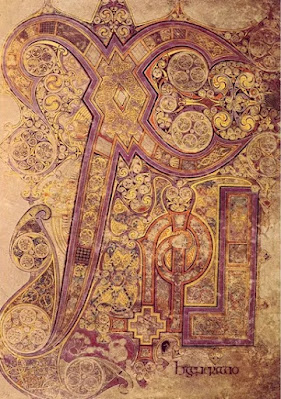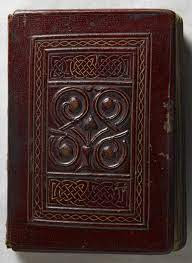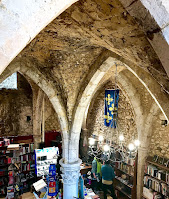The first wave is led by Cessair, a daughter of Noah, who sails westward on a journey that ends in Ireland with 50 women and only three men. Each of the men takes 16 wives, but when two of the men perish leaving only Fintan Mac Bóchra, he flees from the "responsibility" and is turned into a hawk. This hawk lives 5,500 years, advising the kings of Ireland until the 5th century and the time of Finn Mac Cumhaill.
Three centuries after Cessair, another descendant of Noah named Partholón arrives in Ireland with followers. Ireland is wild, with only one open plain and three lakes. They clear more plains, and more lakes appear from the ground. They go about introducing cattle, farming, brewing, etc. They encounter the Fomorians (pictured above in a 1912 painting by John Duncan), monstrous and hostile supernatural beings, and defeat them. Partholón's people, however, numbering 5000 men and 4000 women, all die from a plague within a week. Ireland is left uninhabited, until...
A Scythian named Nemed leads a group of settlers to Ireland. They suffer from plague as well, and also encounter the Fomorians. Losing to the Fomorians, Nemed's people must give two-thirds of their children and wheat and milk to their enemies each Samhain. The Nemedians eventually rise up against the Fomorians, but only 30 survive and are scattered, some going east to become the ancestors of all Britons, some going to Greece, some going north.
The fourth "invasion" is 200 years later, when the descendants of the Nemedians who went to Greece return. This is around the time of the Israelite's Exodus from Egypt. They are called the Fir Bolg, the "men of bags," because while in Greece they were enslaved and made to haul bags of soil and clay. They divide Ireland into five areas ruled by five chieftains.
(An oddly-specific) 37 years later, the fifth wave arrives on dark clouds of fog. They are the Tuatha Dé Danann, bringing the Four Treasures of Ireland (one of which is the Stone of Destiny). They may be descended from the Nemedians who went north. They possess powerful magic, and they demand half of Ireland from the Fir Bolg, who refuse and are slaughtered.
Finally, the Milesians arrive. Their battle with the Tuatha results in an agreement to share the island 50-50: the Milesians get the part above ground, and Tuatha live below the surface. The Milesians are the ancestors of the Gaels. The Tuatha become the Otherworld inhabitants who occasionally encounter humans and exhibit magical powers.
Although humans become the chief peoples of Ireland, the Tuatha part of the story explains the presence of supernatural elements, such as the Four Treasures. What exactly were the Four Treasures and their significance? For that you'll have to come back tomorrow.




























